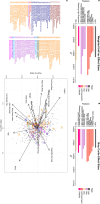Assessing the Variation within the Oral Microbiome of Healthy Adults
- PMID: 32999079
- PMCID: PMC7529435
- DOI: 10.1128/mSphere.00451-20
Assessing the Variation within the Oral Microbiome of Healthy Adults
Abstract
More than 1,000 different species of microbes have been found to live within the human oral cavity, where they play important roles in maintaining both oral and systemic health. Several studies have identified the core members of this microbial community; however, the factors that determine oral microbiome composition are not well understood. In this study, we exam the salivary oral microbiome of 1,049 Atlantic Canadians using 16S rRNA gene sequencing to determine which dietary, lifestyle, and anthropometric features play a role in shaping microbial community composition. Features that were identified as being significantly associated with overall composition then were additionally examined for genera, amplicon sequence variants, and predicted pathway abundances that were associated with these features. Several associations were replicated in an additional secondary validation data set. Overall, we found that several anthropometric measurements, including waist-hip ratio (WHR), height, and fat-free mass, as well as age and sex, were associated with overall oral microbiome structure in both our exploratory and validation data sets. We were unable to validate any dietary impacts on overall taxonomic oral microbiome composition but did find evidence to suggest potential contributions from factors such as the number of vegetable and refined grain servings an individual consumes. Interestingly, each one of these factors on its own was associated with only minor shifts in the overall taxonomic composition of the oral microbiome, suggesting that future biomarker identification for several diseases associated with the oral microbiome can be undertaken without the worry of confounding factors obscuring biological signals.IMPORTANCE The human oral cavity is inhabited by a diverse community of microbes, known as the human oral microbiome. These microbes play a role in maintaining both oral and systemic health and, as such, have been proposed to be useful biomarkers of disease. However, to identify these biomarkers, we first need to determine the composition and variation of the healthy oral microbiome. In this report, we investigate the oral microbiome of 1,049 healthy individuals to determine which genera and amplicon sequence variants are commonly found between individual oral microbiomes. We then further investigate how lifestyle, anthropometric, and dietary choices impact overall microbiome composition. Interestingly, the results from this investigation showed that while many features were significantly associated with oral microbiome composition, no single biological factor explained a variation larger than 2%. These results indicate that future work on biomarker detection may be encouraged by the lack of strong confounding factors.
Keywords: 16S rRNA; microbiome; oral microbiology.
Copyright © 2020 Nearing et al.
Figures





Similar articles
-
New Insights into the Intrinsic and Extrinsic Factors That Shape the Human Skin Microbiome.mBio. 2019 Jul 2;10(4):e00839-19. doi: 10.1128/mBio.00839-19. mBio. 2019. PMID: 31266865 Free PMC article.
-
Determinants and Interactions of Oral Bacterial and Fungal Microbiota in Healthy Chinese Adults.Microbiol Spectr. 2022 Feb 23;10(1):e0241021. doi: 10.1128/spectrum.02410-21. Epub 2022 Feb 2. Microbiol Spectr. 2022. PMID: 35107355 Free PMC article.
-
High-resolution ISR amplicon sequencing reveals personalized oral microbiome.Microbiome. 2018 Sep 5;6(1):153. doi: 10.1186/s40168-018-0535-z. Microbiome. 2018. PMID: 30185233 Free PMC article.
-
Profiling of Oral Bacterial Communities.J Dent Res. 2020 Jun;99(6):621-629. doi: 10.1177/0022034520914594. Epub 2020 Apr 14. J Dent Res. 2020. PMID: 32286907 Free PMC article. Review.
-
The Oral and Gut Bacterial Microbiomes: Similarities, Differences, and Connections.Biol Res Nurs. 2021 Jan;23(1):7-20. doi: 10.1177/1099800420941606. Epub 2020 Jul 21. Biol Res Nurs. 2021. PMID: 32691605 Free PMC article. Review.
Cited by
-
The Oral Microbiome Profile of Water Polo Players Aged 16-20.Sports (Basel). 2023 Nov 7;11(11):216. doi: 10.3390/sports11110216. Sports (Basel). 2023. PMID: 37999433 Free PMC article.
-
Advances in the oral microbiota and rapid detection of oral infectious diseases.Front Microbiol. 2023 Feb 6;14:1121737. doi: 10.3389/fmicb.2023.1121737. eCollection 2023. Front Microbiol. 2023. PMID: 36814562 Free PMC article. Review.
-
Metagenomic analysis reveals associations between salivary microbiota and body composition in early childhood.Sci Rep. 2022 Jul 29;12(1):13075. doi: 10.1038/s41598-022-14668-y. Sci Rep. 2022. PMID: 35906254 Free PMC article.
-
The role of the oral microbiome in obesity and metabolic disease: potential systemic implications and effects on taste perception.Nutr J. 2023 May 27;22(1):28. doi: 10.1186/s12937-023-00856-7. Nutr J. 2023. PMID: 37237407 Free PMC article. Review.
-
Saliva microbiome alterations in dental fluorosis population.J Oral Microbiol. 2023 Feb 20;15(1):2180927. doi: 10.1080/20002297.2023.2180927. eCollection 2023. J Oral Microbiol. 2023. PMID: 36844898 Free PMC article.
References
Publication types
MeSH terms
Substances
LinkOut - more resources
Full Text Sources
